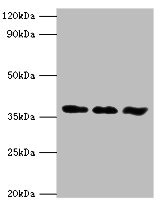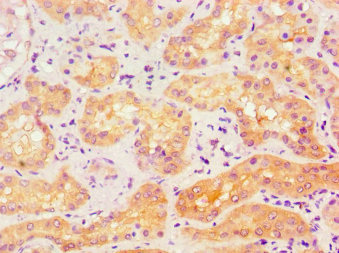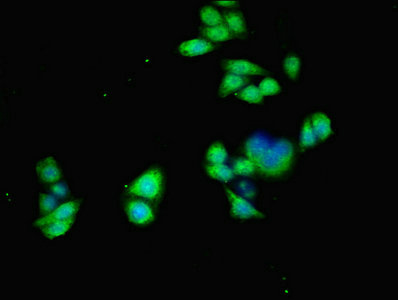ACVR1 Antibody
-
货号:CSB-PA001257ESR2HU
-
规格:¥440
-
促销:
-
图片:
-
Western blot
All lanes: ACVR1 antibody at 6μg/ml
Lane 1: A549 whole cell lysate
Lane 2: HepG2 whole cell lysate
Lane 3: Mouse gonad tissue
Secondary
Goat polyclonal to rabbit IgG at 1/10000 dilution
Predicted band size: 39 kDa
Observed band size: 39 kDa -
Immunohistochemistry of paraffin-embedded human kidney tissue using CSB-PA001257ESR2HU at dilution of 1:100
-
Immunofluorescent analysis of PC-3 cells using CSB-PA001257ESR2HU at dilution of 1:100 and Alexa Fluor 488-congugated AffiniPure Goat Anti-Rabbit IgG(H+L)
-
-
其他:
产品详情
-
产品名称:Rabbit anti-Homo sapiens (Human) ACVR1 Polyclonal antibody
-
Uniprot No.:Q04771
-
基因名:
-
别名:Activin A receptor type I antibody; Activin A receptor type II like kinase 2 antibody; Activin receptor type I antibody; Activin receptor type-1 antibody; Activin receptor-like kinase 2 antibody; ACTR-I antibody; ACTRI antibody; Acvr1 antibody; ACVR1_HUMAN antibody; ACVR1A antibody; ACVRLK2 antibody; ALK 2 antibody; ALK-2 antibody; ALK2 antibody; FOP antibody; Hydroxyalkyl protein kinase antibody; Serine/threonine-protein kinase receptor R1 antibody; SKR1 antibody; TGF-B superfamily receptor type I antibody; TGFB superfamily receptor type I antibody; TSR-I antibody; TSRI antibody
-
宿主:Rabbit
-
反应种属:Human, Mouse
-
免疫原:Recombinant Human Activin receptor type-1 protein (20-125AA)
-
免疫原种属:Homo sapiens (Human)
-
标记方式:Non-conjugated
-
克隆类型:Polyclonal
-
抗体亚型:IgG
-
纯化方式:Antigen Affinity Purified
-
浓度:It differs from different batches. Please contact us to confirm it.
-
保存缓冲液:PBS with 0.02% sodium azide, 50% glycerol, pH7.3.
-
产品提供形式:Liquid
-
应用范围:ELISA, WB, IHC, IF
-
推荐稀释比:
Application Recommended Dilution WB 1:500-1:2000 IHC 1:20-1:200 IF 1:50-1:200 -
Protocols:
-
储存条件:Upon receipt, store at -20°C or -80°C. Avoid repeated freeze.
-
货期:Basically, we can dispatch the products out in 1-3 working days after receiving your orders. Delivery time maybe differs from different purchasing way or location, please kindly consult your local distributors for specific delivery time.
相关产品
靶点详情
-
功能:Bone morphogenetic protein (BMP) type I receptor that is involved in a wide variety of biological processes, including bone, heart, cartilage, nervous, and reproductive system development and regulation. As a type I receptor, forms heterotetrameric receptor complexes with the type II receptors AMHR2, ACVR2A ors ACVR2B. Upon binding of ligands such as BMP7 or GDF2/BMP9 to the heteromeric complexes, type II receptors transphosphorylate ACVR1 intracellular domain. In turn, ACVR1 kinase domain is activated and subsequently phosphorylates SMAD1/5/8 proteins that transduce the signal. In addition to its role in mediating BMP pathway-specific signaling, suppresses TGFbeta/activin pathway signaling by interfering with the binding of activin to its type II receptor. Besides canonical SMAD signaling, can activate non-canonical pathways such as p38 mitogen-activated protein kinases/MAPKs.
-
基因功能参考文献:
- Identification of small molecule inhibitors of ALK2: a virtual screening, density functional theory, and molecular dynamics simulations study. PMID: 30159679
- Results showed that ACVR1 was a direct target of miR-384 and was involved in the inhibitory effects of miR-384 on breast cancer progression. Furthermore, the study indicated that ACVR1 activated the Wnt/beta-catenin signaling pathway in breast cancer. PMID: 29693185
- Study emphasizes about the role of ACVR1 which encoding a receptor for BMP proteins in fibrodysplasia ossificans progressiva (FOP). Most FOP patients carry the recurrent R206H substitution in the GS domain, whereas a few other mutations are responsible for limited cases. Mutations cause a dysregulation of the downstream BMP-dependent pathway making mutated ACVR1 responsive to a non-canonical ligand, Activin A. [review] PMID: 29587443
- The role of an ALK2 mutation (R258S) in IRIDA development in a patient also bearing compound heterozygous mutations in TMPRSS6 was demonstrated by reconstructing in vitro the proband's genotype, expressing mutants TMPRSS6 and ACVR1 in the presence of hemojuvelin and assessing hepcidin activation. ALK2(R258S) maintained high hepcidin expression in the presence of MT2(I212T). PMID: 28476747
- activation of AMPK upregulated Smad6 and Smurf1 and thereby enhanced their interactions, resulting in its proteosome-dependent degradation of ALK2. PMID: 28847510
- the Fibrodysplasia Ossificans Progressiva mutation ACVR1(R206H) is more sensitive to a number of natural ligands. PMID: 27713089
- both bone morphogenetic protein 2 (BMP2) and BMP6 are proangiogenic in vitro and ex vivo and that the BMP type I receptors, activin receptor-like kinase 3 (ALK3) and ALK2, play crucial and distinct roles in this process. PMID: 28733457
- Fibrodysplasia ossificans progressiva (FOP) syndrome is caused by mutation of the gene ACVR1. Developed is a simplified one-step procedure by simultaneously introducing reprogramming and gene-editing components into human fibroblasts derived from patient with FOP. The one-step-mediated ALK2 gene-corrected induced pluripotent stem cells restored global gene expression pattern. PMID: 27256111
- The ACVR1 R206H mutation may not directly increase the formation of mature chondrogenic or osteogenic cells. PMID: 27530160
- s demonstrated that the BMP type I receptor ALK-2 (encoded by the ACVR1 gene) has crucial roles in apoptosis induction of patient-derived glioma-initiating cells (GICs), TGS-01 and TGS-04. PMID: 28459464
- Data suggest BMP9/GDF2 and BMP10 synergize with TNFA to increase monocyte recruitment to vascular endothelial cells; process appears to be mediated mainly via ALK2/ACVR1 (which exhibits protein kinase activity). These studies used in vitro flow monocyte adhesion assay. (BMP9 = growth differentiation factor 2; BMP10 = bone morphogenetic protein 10; TNFA = tumor necrosis factor alpha; ALK2/ACVR1 = activin A receptor type 1) PMID: 28646109
- The effects of ACVR1/ALK2 mutations causing fibrodysplasia ossificans progressiva are extended to the central nervous system. Brainstem hamartomatous lesions and dysmorphisms, variably associated with dentate nucleus and basal ganglia signal abnormalities and/or calcifications, may represent useful disease hallmarks. PMID: 27565519
- Low ALK2 expression is associated with invasiveness of breast cancer. PMID: 28075462
- Further investigation on clinical ESCC samples and non-tumorous adjacent tissue found that tumors with triple-positive BMP6, ALK2 and BMPRII had deeper growth than tumors with only BMP6 expression PMID: 27959431
- The clinical manifestations, the disease course, and the molecular findings of involvement of ACVR1 gene in this family are suggestive of "FOP variant" or an unusual ACVR1-related skeletal dysplasia PMID: 27182040
- Activin-A is increased in the airway of asthmatics and peaks during asthma exacerbations.Activin-A signalling pathways are dysregulated in severe asthma. PMID: 26869672
- Common mutations in ALK2/ACVR1, a multi-faceted receptor, have roles in distinct pediatric musculoskeletal and neural orphan disorders. PMID: 26776312
- The higher PE activin A concentrations resulted in abnormal endothelial functions, which may contribute to the systemic maternal vascular endothelial cell dysfunction observed in the disorder. PMID: 26597752
- A report of two patients has been presented with multi-system involvement in a severe variant of fibrodysplasia ossificans progressiva caused by the ACVR1 c.772G>A; R258G mutation. PMID: 26097044
- Fibrodysplasia ossificans progressiva-ACVR1 abnormally transduces bone morphogenetic protein signaling in response to Activin-A. PMID: 26621707
- Changes in the binding site residue(e.g. pre-hinge region in ALK2) or side chain orientation (e.g. Tyr219 in caALK2 vs. wtALK2), or ligand modification (e.g. DMH1 vs. LDN193189) causes distinct binding profiles and selectivity among BMP inhibitors. PMID: 26133550
- heterozygous mutation i.e., c.617(G>A)in ACVR1 was detected in patients with rare genetic disorder - Fibrodysplasia ossificans progressiva PMID: 23918320
- miR-148a is an important mediator of ACVR1, thus offering a new potential target for the development of therapeutic agents against Fibrodysplasia ossificans progressiva. PMID: 22408438
- Genetic analysis of ACVR1 identified the recurrent allelic variant c.617 G>A; p.R206H in 12 of 14 Fibrodysplasia Ossificans Progressiva (FOP)patients. One of the remaining patients had a previously reported allele c.1067G>A; p.G356D in the 9th exon and the second allele c.983G>A; p.G328E in the 8th exon of ACVR1. PMID: 26058333
- clinically aggressive stem cell-like subtype of hepatocellular carcinoma characterized by miR-148a-ACVR1-BMP-Wnt circuit PMID: 25271001
- compounds demonstrated consistent binding to a panel of mutant and wild-type ALK2 proteins PMID: 25101911
- ALK2 (R206H) mutation increases osteoclast formation through TGF-beta. The activation of activin-like kinase signaling enhanced osteoclast formation through TGF-beta expression during heterotopic ossification in muscle tissues. PMID: 24798338
- The findings provide novel insights into the molecular mechanisms that regulate expression of the ACVR1 gene and that could be targets of new strategies for future therapeutic treatments. PMID: 24047559
- Recurrent somatic mutations in ACVR1 in pediatric midline high-grade astrocytoma. PMID: 24705250
- Recurrent somatic mutations in ACVR1 found in diffuse intrinsic pontine gliomas. PMID: 24705251
- Recurrent activating ACVR1 mutations in diffuse intrinsic pontine glioma. PMID: 24705252
- ACVR1 mutations in diffuse intrinsic pontine gliomas were constitutively activating, leading to SMAD phosphorylation and increased expression of the downstream activin signaling targets ID1 and ID2. PMID: 24705254
- Glucocorticoids recruit Tgfbr3 and Smad1 to shift transforming growth factor-beta signaling from the Tgfbr1/Smad2/3 axis to the Acvrl1/Smad1 axis in lung fibroblasts. PMID: 24347165
- Presence of the 455C allele of BMP4 and the 8474T allele of ACVR1 gene was significantly associated with decreased left ventricular ejection fraction (LVEF) (p=0.0004 and p=0.046, respectively). PMID: 22971142
- ALK2 may be an important receptor in ET-1 production during BMPR2 knockdown PMID: 23142694
- Functional analysis of the 3'UTR region by Luciferase reporter assays showed that it plays an inhibitory role on ACVR1/Alk-2 gene expression. PMID: 23227223
- Fibrodysplasia ossificans progressiva has been linked to an autosomal dominant mutation on chromosome 2, to the gene encoding activin receptor-like kinase 2 (ALK2), a BMP type I receptor PMID: 22630080
- Disease causing mutations in the ACVR1 gene identified in Turkish patients diagnosed as fibrodysplasia ossificans progressiva. PMID: 23260810
- Constitutive activation of ALK2 such as that caused by the Fibrodysplasia Ossificans Progressiva mutation inhibits the generation and maintenance of human induced pluripotent stem cells. PMID: 22949078
- Luminal iron levels govern intestinal tumorigenesis after Apc loss in vivo. PMID: 22884369
- Study suggests that activin A contributes to the malignant phenotype of malignant pleural mesothelioma (MPM) cells via regulation of cyclin D and may represent a valuable candidate for therapeutic interference. PMID: 23169291
- miR-30c expression was increased during adipogenesis of multipotent adipose-derived stem cells; miRNA target prediction revealed 2 putative direct targets of miR-30c, PAI-1 and ALK2, both inversely regulated to miR-30c during adipogenesis and responsive to miR-30c overexpression PMID: 21878751
- The crystal structure of the cytoplasmic domain of ALK2 in complex with the inhibitors FKBP12 and dorsomorphin. PMID: 22977237
- Confirmation of the presence of this recurrent mutation facilitates diagnostic accuracy in affected persons in South Africa, and allows researchers to narrow the search for molecular targets for rational intervention to the ACVR1/ALK2 domain. PMID: 22748444
- copy number alterations at 2q24 can be involved in ACVR1 overexpression, which is associated with longer overall survival in laryngeal carcinomas PMID: 21668474
- Low activin A in the cytosol is associated with upper urinary tract urothelial carcinoma. PMID: 21617230
- These data indicate that in the context of a Down's syndrome background, ALK2-mediated reduction of BMP signaling may contribute to congenital heart defects. PMID: 21248739
- These findings suggest that ALK2(L196P) is an activated BMP receptor equivalent to ALK2(R206H) and that ALK2(L196P) activity may be suppressed in vivo by a novel molecular mechanism in fibrodysplasia ossificans progressiva patients with this mutation. PMID: 21377447
- in two cases of fibrodysplasia ossificans progressiva, heterozygous missense mutation 617G>A (R206H) was found PMID: 20736820
- Progressive heterotopic ossification along with congenital malformation of the great toes, the two major clinical features that define classic FOP, led to a suspicion of FOP and to the definitive screening of the ACVR1 gene PMID: 20577760
显示更多
收起更多
-
相关疾病:Fibrodysplasia ossificans progressiva (FOP)
-
亚细胞定位:Membrane; Single-pass type I membrane protein.
-
蛋白家族:Protein kinase superfamily, TKL Ser/Thr protein kinase family, TGFB receptor subfamily
-
组织特异性:Expressed in normal parenchymal cells, endothelial cells, fibroblasts and tumor-derived epithelial cells.
-
数据库链接:
HGNC: 171
OMIM: 102576
KEGG: hsa:90
STRING: 9606.ENSP00000263640
UniGene: Hs.470316
Most popular with customers
-
-
YWHAB Recombinant Monoclonal Antibody
Applications: ELISA, WB, IF, FC
Species Reactivity: Human, Mouse, Rat
-
Phospho-YAP1 (S127) Recombinant Monoclonal Antibody
Applications: ELISA, WB, IHC
Species Reactivity: Human
-
-
-
-
-
























